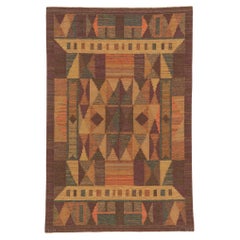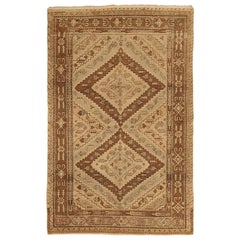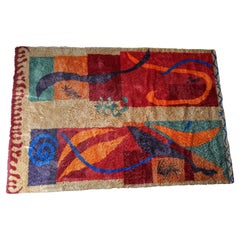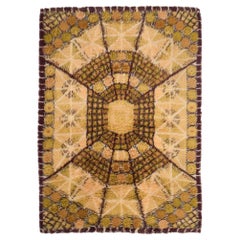20th Century Russian and Scandinavian Rugs
to
392
Width
to
Length
to
2,133
752
369
29
23
23
11
11
3
2
1
8
237
2,133
1,699
434
1,346
138
205
19
61
38
55
125
175
68
5
4
2,079
1,899
399
49
22
1,537
576
2,133
2,133
2,133
1,549
1,398
1,006
414
287
68
58
29
19
17
Period: 20th Century
Inga-Mi Vannerus Rydgren Vintage Swedish Rollakan Rug, Jönköpings Läns Hemslöjd
By Inga-Mi Vannérus-Rydgran
Located in Dallas, TX
78494 Inga-Mi Vannerus Rydgren Vintage Swedish Kilim Rollakan Rug, 05'02 x 08'00. Emanating Scandinavian Modern style with incredible detail and texture, this handwoven wool Swedish ...
Category
Swedish Scandinavian Modern 20th Century Russian and Scandinavian Rugs
Materials
Wool
$10,080 Sale Price
20% Off
Antique Russian Khotan Rug with Brown Diamond Details on Beige Field
Located in Dallas, TX
Antique Russian rug handwoven from the finest sheep’s wool and colored with all-natural vegetable dyes that are safe for humans and pets. Its woven using Khotan design featuring larg...
Category
Persian Sarouk Farahan Vintage 20th Century Russian and Scandinavian Rugs
Materials
Wool
$3,440 Sale Price
20% Off
8x10 Vintage Scandinavian Ege Rya Shag Wool Area Rug
By Ege Rya
Located in Las Vegas, NV
EXACT DIMENSIONS TO BE CONFIRMED rug is approximately 8x10
You are looking at a Classic example of a Scandinavian Rya rug. Purchased from the original owner who purchased it from Bu...
Category
Mid-Century Modern 20th Century Russian and Scandinavian Rugs
Materials
Wool
Marianne Richter for Märta Måås-Fjetterström 'Fläder Röd' Carpet in Wool
Located in Waalwijk, NL
Marianne Richter for Märta Måås-Fjetterström AB (MMF AB), rölakan flat weave carpet 'Fläder Röd', wool, Sweden, design 1943
An exceptional rare piece designed by female textile art...
Category
Swedish Scandinavian Modern Vintage 20th Century Russian and Scandinavian Rugs
Materials
Wool
Marianne Richter, Sweden. Large "Löfstad" rya carpet. Modernist design.
Located in København, Copenhagen
Marianne Richter, Sweden. Large "Löfstad" rya carpet.
Modernist design.
From the 1960s/70s.
In excellent condition.
Dimensions: 191 cm x 140 cm.
Category
Swedish Scandinavian Modern Vintage 20th Century Russian and Scandinavian Rugs
Materials
Wool
Doris Leslie Blau Mid-20th Century Swedish Flat Weave Rug
Located in New York, NY
Mid-20th Century Swedish Flat Weave Rug.
Size: 5'7" × 8'0" (170 × 243 cm).
This charming mid-century Swedish flat-weave rug exemplifies the serene elegance and geometric sophisticati...
Category
Scandinavian Mid-Century Modern 20th Century Russian and Scandinavian Rugs
Materials
Wool
Vintage Black Ground Oversize Bessarabian Kilim with Botanical Pattern
Located in Milan, IT
The kilims known as 'Bessarabian' were woven in the Russian regions of Ukraine and Moldovia. Intended to satisfy the demands of the Russian aristocracy at a time when continental int...
Category
Ukrainian Bessarabian Vintage 20th Century Russian and Scandinavian Rugs
Materials
Wool
Rya Rug Minimalist Design Mollaianrugs Collection
Located in Ferrara, IT
This is a vintage Rya carpet woven in Sweden during the mid-20th century circa 1950 - 1970s and measures 204 x 145CM in size. This carpet has a simp...
Category
Swedish Scandinavian Modern 20th Century Russian and Scandinavian Rugs
Materials
Wool
$1,795 Sale Price
20% Off
Vintage Scandinavian Swedish Kilim. Size: 7 ft 10 in x 12 ft
Located in New York, NY
Vintage Scandinavian Swedish Kilim, country of origin: Sweden, date circa midcentury. Size: 7 ft. 10 in x 12 ft. (2.39 m x 3.66 m)
This idyllic midcentury Scandinavian rug captures ...
Category
Swedish Mid-Century Modern 20th Century Russian and Scandinavian Rugs
Materials
Wool
Barbro Nilsson "Falurutan" Carpet for MMF
Located in Pawtucket, RI
Hand-woven wool "Falurutan" carpet designed by important Swedish textile artist Barbro Nilsson for Marta Maas-Fjetterström AB, Sweden. Woven signature t...
Category
Swedish Mid-Century Modern Vintage 20th Century Russian and Scandinavian Rugs
Materials
Wool
Finish Art Deco Rug by Greta Skoaster Woven at Kiikan Kutamo Workshop
Located in New York, NY
Finish Art Deco rug by Greta Skoaster woven at Kiikan Kutamo Workshop
Size: 8'0" × 11'8" (243 × 355 cm)
A masterwork of Nordic modernism, this vintage Finnish Art Deco rug by Greta Skogster, woven at the esteemed Kiikan Kutomo...
Category
Finnish Art Deco 20th Century Russian and Scandinavian Rugs
Materials
Wool
1960's HOJER EKSPORT WILTON Danish Modern Wool Rya Rug Tapestry Mid Century
Located in Los Angeles, CA
From a crazy collection that was kept in storage for decades!
All new UNUSED vintage 60's/70's Rugs!
WILTON 2 Rectangular Brown Green Rya Rug
Creator: Hojer Eksport Wilton (Manufac...
Category
Danish Scandinavian Modern Vintage 20th Century Russian and Scandinavian Rugs
Materials
Wool
Mid century Danish Ege Rya wool rug 6' x 9'
By Ege Rya
Located in Liberty, NY
Beautiful mid century Ege Rya rug in cream and browns,
pile is in nice condition. Does not retain label, but i have seen this pattern documented with the Ege Rya label on it.
Category
Danish Scandinavian Modern Vintage 20th Century Russian and Scandinavian Rugs
Materials
Wool
Doris Leslie Blau Vintage Swedish Pile Rug in Geometric Checkerboard Design
Located in New York, NY
Vintage Swedish Pile Rug in Geometric Checkerboard Design
Size: 3'0" × 6'0" (91 × 182 cm)
This charming vintage Swedish pile rug, dating from the mid-20th century, exemplifies the fu...
Category
Swedish Mid-Century Modern 20th Century Russian and Scandinavian Rugs
Materials
Wool
Red Vintage Scandinavian Swedish Rya Shag Rug 4' x 6'
Located in New York, NY
Red Vintage Scandinavian Swedish Rya Shag Rug, Origin: Sweden, Circa: Mid-20th Century
Category
Swedish Scandinavian Modern 20th Century Russian and Scandinavian Rugs
Materials
Wool
Rya Swedish Rug Mid-Century Modern Vintage Design
Located in Ferrara, IT
This is a vintage Swedish rug woven during the mid-20th century circa 1950 – 1970’s and measures 200 x 145 CM in size. This rug has an all-over floral design with two bouquets enclos...
Category
Swedish Scandinavian Modern 20th Century Russian and Scandinavian Rugs
Materials
Wool
Swedish Geometric Flat-Weave Rug Signed MLB 1950s Scandinavian Artist
Located in Las Vegas, NV
Exceptional Swedish flat-weave Kilim rug.
Gorgeous blues and whites in a mesmerizing geometric design.
Signed by the weaver "MLB".
Measures: 84 x 57".
Category
Swedish Mid-Century Modern 20th Century Russian and Scandinavian Rugs
Materials
Wool
20th Century Traditional Swedish Rug
Located in Tetbury, Gloucestershire
Traditional 20th Century Swedish rug in red, blue, black, orange and green.
Circa 1950.
Category
Swedish 20th Century Russian and Scandinavian Rugs
Materials
Cotton
20th Century Swedish Rag Rug
Located in Tetbury, Gloucestershire
20th century Swedish rag rug. Featuring a stripe design in tones of blue, black, red and ecru. This rug does show signs of wear that are in the form of a stain. This rug is machine w...
Category
Swedish 20th Century Russian and Scandinavian Rugs
Materials
Cotton
Swedish RYA Rug
Located in London, England
Mid-Century Swedish RYA rug in deep tones of blues, purples and orange. Sweden circa 1970. All our carpets undergo a professional cleaning process. However, due to their age and prev...
Category
Vintage 20th Century Russian and Scandinavian Rugs
Materials
Wool
$776
Vintage Hand-woven Signed Marta Maas-Fjetterstrom Blue Swedish Wool Rug
Located in West Hollywood, CA
This signed Swedish rug features a field with eight horizontal rows and four vertical rows of deep blue and light blue rectangular panels divided by a framework of ivory and biscuit-...
Category
Swedish 20th Century Russian and Scandinavian Rugs
Materials
Wool
Mid 20th century Swedish flat weave rug
By Ida Rydelius
Located in London, GB
A lovely mid 20th century Swedish flat weave rug.
It has three styished elongated geometric shapes in yellow and blue set on a cream background which is framed by a yellow and mid b...
Category
Swedish Mid-Century Modern 20th Century Russian and Scandinavian Rugs
Materials
Wool
Rya carpet, Sweden. Handwoven. Modernist design. 1958
Located in København, Copenhagen
Rya carpet, Sweden. Handwoven.
Modernist design.
Signed GEB 1958.
In excellent condition.
Dimensions: 166 cm x 103 cm.
Category
Swedish Scandinavian Modern Vintage 20th Century Russian and Scandinavian Rugs
Materials
Wool
Midcentury EGE VAEGRYA Danish Scandinavian Owl Wall hanging Tapestry Art Rug 70s
By Ege Tæpper, Ege Rya
Located in Sherborne, Dorset
A rare Scandinavian RYA wall hanging tapestry designed in the 1970s for EGE Rya, a subsidiary of Denmark's prestigious carpet manufacturer, EGE Taepper. The bold and whimsical design...
Category
Danish Scandinavian Modern 20th Century Russian and Scandinavian Rugs
Materials
Wool, Wood
Vintage Finnish Rya Ryijy Rug with Union Jack Motifs and Cool Britannia Style
Located in Dallas, TX
78270 Vintage Finnish Rya Ryijy rug with Cool Britannia style 03'01 x 05'07. Full of tiny details and a bold expressive design combined with Cool Britannia...
Category
Finnish Scandinavian Modern 20th Century Russian and Scandinavian Rugs
Materials
Wool
$3,399 Sale Price
20% Off
Swedish reversible flatweave carpet by Ingrid Dessau for Kasthall, 1950s
Located in Eskilstuna, SE
Flatweave carpet designed by artist Ingrid Dessau for Kasthall, Sweden, during the 1950s.
Reversible with both sides of beautiful color and patterns.
Category
Swedish Scandinavian Modern 20th Century Russian and Scandinavian Rugs
Materials
Wool
Small Danish Midcentury Wool Carpet / Rug, 1970s
Located in Praha, CZ
- 1970
- Good original condition, bright colors.
Category
Danish Scandinavian Modern Vintage 20th Century Russian and Scandinavian Rugs
Materials
Wool
Sweden, Rölakan technic runner in handwoven wool. Modernist design.
Located in København, Copenhagen
Sweden, Rölakan technic runner in handwoven wool.
Modernist design.
Mid-20th century.
In excellent condition.
Dimensions: 243 cm x 84 cm.
Category
Swedish Scandinavian Modern 20th Century Russian and Scandinavian Rugs
Materials
Wool
Doris Leslie Blau Vintage Swedish Flat Woven Rug
Located in New York, NY
Vintage Swedish Flat Woven Rug
Size: 4'7" × 6'8" (139 × 203 cm)
A striking example of Scandinavian modernism, this vintage Swedish flatweave rug captures the essence of mid-century t...
Category
Swedish Mid-Century Modern 20th Century Russian and Scandinavian Rugs
Materials
Wool
Vintage Swedish Mid-Century Modern Shag Rya Rug
Located in Atlanta, GA
Bright and cheerful Swedish Modern Rya rug. Light gold, cream, lavender, and plum with a geometric pattern. Hand-hooked of wool yarn, this is the perfect petite rug...
Category
Swedish Scandinavian Modern Vintage 20th Century Russian and Scandinavian Rugs
Materials
Wool
Berit Koenig "Viggen, Blå" Flat Weave by Svensk Hemslöjd Signed BK and SH
Located in Los Angeles, CA
Berit Koenig "Viggen, Blå" flat weave by Svensk Hemslöjd signed BK and SH
This rug by Berit Koenig titled "Viggen, Blå" or Blue Thunderbolt has a table of a stripe and zigzag patt...
Category
Swedish Scandinavian Modern 20th Century Russian and Scandinavian Rugs
Materials
Wool
$3,080 Sale Price
20% Off
Doris Leslie Blau Midcentury Swedish Yellow Brown Handwoven Wool Rug
Located in New York, NY
Mid-20th century Swedish yellow, brown and white handwoven wool rug
Size: 5'6" × 8'0" (167 × 243 cm)
This striking vintage Swedish flat-weave rug, attributed to the renowned textile ...
Category
Swedish Mid-Century Modern 20th Century Russian and Scandinavian Rugs
Materials
Wool
Doris Leslie Blau Swedish Flat Woven Rug by Alice Lund
By Alice Lund
Located in New York, NY
Swedish Flat Woven Rug by Alice Lund
Size: 7'11" × 10'0" (241 × 304 cm)
This 1950s vintage Swedish flat-weave rug designed by Alice Lund is a striking example of Scandinavian moderni...
Category
Scandinavian Mid-Century Modern 20th Century Russian and Scandinavian Rugs
Materials
Wool
20th Century Swedish Rag Rug
Located in Tetbury, Gloucestershire
Traditional 20th Century Swedish rag rug.
Featuring a lovely striped design throughout in various shades of blue.
This rug is machine washable at 30 degrees.
Stock Number: RT60...
Category
Swedish 20th Century Russian and Scandinavian Rugs
Materials
Fabric
Vintage Swedish Flat-Weave Rug in Floral Design
Located in New York, NY
Vintage Swedish Flat-Weave Rug in Floral Design
Size: 4'6" × 6'8" (137 × 203 cm)
This charming vintage Swedish flat-weave rug exudes joyful elegance with its expressive floral design...
Category
Swedish Mid-Century Modern 20th Century Russian and Scandinavian Rugs
Materials
Wool
20th Century Traditional Swedish Rug
Located in Tetbury, Gloucestershire
Vintage Swedish multicoloured striped cotton rug. Circa 1950. Bag 11 / Rug 106
Category
Swedish 20th Century Russian and Scandinavian Rugs
Materials
Cotton
Modernist Abstract Ege Rya Rug, 9 x 7, Blues and Greens
By Ege Rya
Located in Buffalo, NY
Modernist Abstract Ege Rya Rug, 9 x 7, Blues and Greens . Pop 60's , 70's..Amazing Modern Space Age Design, Nice original condition,,a good cleaning would bring back the pile,
Category
Danish Mid-Century Modern Vintage 20th Century Russian and Scandinavian Rugs
Materials
Wool
Rug 'Ursula' by Märta Måås-Fjetterström for MMF AB, Sweden, 1930s
Located in Stockholm, SE
Model Ursula by Märta Måås-Fjetterström for MMF AB, Sweden, 1935.
Category
Swedish Scandinavian Modern Vintage 20th Century Russian and Scandinavian Rugs
Materials
Wool
Flat-Weave Rug by Marta Maas-Fjetterström
Located in Long Island City, NY
Vintage Swedish flat-weave, "VITA Rutmattan" rug, designed by Marta Maas-Fjetterström (1873-1941). Dimensions: 210 x 138 cm. (84" x 54.3").
Marked AB MMF.
Designed in 1933. Woven a...
Category
Swedish Scandinavian Modern Vintage 20th Century Russian and Scandinavian Rugs
Materials
Wool
Vintage Scandinavian Verner Panton Textile.7 ft 9 in x 7 ft 9 in
Located in New York, NY
Vintage Scandinavian Verner Panton “mira Spectrum” Textile, Country of Origin: Scandinavia, Circa date: Mid-20th Century. Size: 7 ft 9 in x 7 ft 9 in (2.36 m x 2....
Category
Scandinavian Mid-Century Modern 20th Century Russian and Scandinavian Rugs
Materials
Linen
Antique RussianKilim Rug in Blue Embroidered Geometric Pattern by Rug & Kilim
Located in Long Island City, NY
Originating between 1920-1930, a rare 4x10 antique Caucasian kilim rug believed to be of Russian tribal provenance.
Handwoven in all wool, the gorgeous design witnesses meticulou...
Category
Russian Kilim Vintage 20th Century Russian and Scandinavian Rugs
Materials
Wool
Wonderful Large Size Swedish Rya Rug, Mid-Century Modern
Located in Pemberton, NJ
Wonderful large sized Swedish rya rug in wonderful vintage condition. Fiery warm tones, understated neutrals and crisp jet black background details are juxtaposed in this luxurious ...
Category
Swedish Mid-Century Modern Vintage 20th Century Russian and Scandinavian Rugs
Materials
Wool
60's AIDA Rooster Cock Wool UNUSED Mid Century Modern Rya Rug Cream Yellow
Located in Los Angeles, CA
From a crazy collection that was kept in storage for decades!
All new UNUSED vintage 60's/70's Rugs!
AIDA Cock Cream Yellow Beige Copper Orange Brown Rya Rug
Creator: Aida
100% A...
Category
Austrian Vintage 20th Century Russian and Scandinavian Rugs
Materials
Wool
Doris Leslie Blau Vintage Swedish Flat Woven by Judith Johansson
Located in New York, NY
Vintage Swedish Flat Woven by Judith Johansson
Size: 6'0" × 7'10" (182 × 238 cm)
The vintage Swedish flat-woven rug "Myosotis" by Judith Johansson (1916–1993) is a masterful example...
Category
Swedish Mid-Century Modern 20th Century Russian and Scandinavian Rugs
Materials
Wool
Doris Leslie Blau Vintage Swedish Flat-Weave Rug Signed 'JR'
Located in New York, NY
Vintage Swedish Flat-Weave Rug Signed 'JR'
Size: 4'3" × 6'7" (129 × 200 cm).
This exceptional vintage Swedish flat-weave rug, signed 'JR', captures the essence of mid-century Scandin...
Category
Swedish Mid-Century Modern 20th Century Russian and Scandinavian Rugs
Materials
Wool
Doris Leslie Blau Vintage Swedish Flat-Weave Wool Rug by Konstfliten–Bohusslöjd
Located in New York, NY
Vintage Swedish Flat-Weave Wool Rug by Konstfliten–Bohusslöjd
Size: 4'9" × 6'9" (144 × 205 cm)
This mid-century Swedish flat-weave rug, attribut...
Category
Swedish Mid-Century Modern 20th Century Russian and Scandinavian Rugs
Materials
Wool
Large Vintage Swedish Kilim
Located in London, England
Large mid-century Swedish kilim in tones of purple and cream. Professionally cleaned. Signed IJ. All our vintage carpets undergo a professional cleaning process. However, due to thei...
Category
Mid-Century Modern 20th Century Russian and Scandinavian Rugs
Materials
Wool
Mid-20th Century Swedish Rug Signed by Ingegerd Silow
Located in West Hollywood, CA
This vintage handwoven Swedish rug has a cool tonal overall field with oblong stepped lozenge lattice, in a complementary stylized geometric “S-motif” border. Signed by the original ...
Category
Swedish Mid-Century Modern Vintage 20th Century Russian and Scandinavian Rugs
Materials
Wool
20th Century Traditional Swedish Rug
Located in Tetbury, Gloucestershire
Vintage Swedish 20th century rug in orange, black and pink. Circa 1950. Bag 12 / Rug 115
Category
Swedish 20th Century Russian and Scandinavian Rugs
Materials
Cotton
Rya carpet, Sweden. Modernist design. From the 1970s.
Located in København, Copenhagen
Rya carpet, Sweden.
Modernist design.
From the 1970s.
In excellent condition.
Dimensions: 128 cm x 78 cm.
Category
Swedish Scandinavian Modern Vintage 20th Century Russian and Scandinavian Rugs
Materials
Wool
Ulla Parkdah Swedish Flat-Weave Rug, Signed UP, Sweden, 1960s
By Ulla Parkdal
Located in Los Angeles, CA
Ulla Parkdah Swedish flat-weave rug, signed UP, Sweden, 1960s
This particular Swedish carpet is a wonderful representation of midcentury Scandinavian r...
Category
Swedish Scandinavian Modern 20th Century Russian and Scandinavian Rugs
Materials
Wool
$1,400 Sale Price
37% Off
Vintage Swedish Green Flat Woven Rug Doris Leslie Blau
Located in New York, NY
Vintage Swedish Green Flat Woven Rug
Size: 6'1" × 10'0" (185 × 304 cm)
This vintage Swedish flat-weave rug showcases a beautifully balanced striped pattern, emphasizing the simplicit...
Category
Scandinavian Mid-Century Modern 20th Century Russian and Scandinavian Rugs
Materials
Wool
Swedish textile designer. Handwoven carpet in pure wool. Pink and blue colors.
Located in København, Copenhagen
Swedish textile designer.
Handwoven carpet in pure wool. Rölakan technique.
Geometric pattern.
Pink and blue colors.
Mid-20th century.
In excellent condition with minimal signs of us...
Category
Swedish Scandinavian Modern 20th Century Russian and Scandinavian Rugs
Materials
Wool
Swedish designer, handwoven rya carpet. Geometric pattern, ca 1970
Located in København, Copenhagen
Swedish designer, handwoven rya carpet.
Geometric pattern in blue, violet, and green colors.
Approx 1970.
Perfect condition.
Dimensions: 140 cm x 97 cm.
Category
Swedish Scandinavian Modern Vintage 20th Century Russian and Scandinavian Rugs
Materials
Wool
Vintage Swedish Flat Woven Rug Doris Leslie Blau
Located in New York, NY
Vintage Swedish Flat Woven Rug
Size: 5'2" × 7'9" (157 × 236 cm)
This vintage Swedish flat-weave rug by Ingegerd Silow is a stunning example of Scandinavian textile artistry, blending...
Category
Scandinavian Mid-Century Modern 20th Century Russian and Scandinavian Rugs
Materials
Wool
Antique Scandinavian Art Deco/Bauhaus Rug by Laila Karttunen
Located in Milan, IT
Laila Maria Karttunen (1895-1981) was a leading Finnish textile artist. After graduating from the Turku School of Art and Design, she initially taught at the Wetterhoff weaving schoo...
Category
Finnish Scandinavian Modern Vintage 20th Century Russian and Scandinavian Rugs
Materials
Wool
Swedish designer, handwoven rya carpet in blue, violet, and green colours.
Located in København, Copenhagen
Swedish designer, handwoven rya carpet.
Geometric pattern in blue, violet, and green colors.
Approximately 1970.
Perfect condition.
Dimensions: 136 cm x 85 cm.
Category
Swedish Scandinavian Modern Vintage 20th Century Russian and Scandinavian Rugs
Materials
Wool
Early 20th Century Caucasian Kazak Throw Rug
Located in New York, NY
An antique Caucasian Kazak throw rug. The red field is divided by a subtle trellis with geometric palmettes and leaves in a manner original to Kuba rugs from the northeast Caucasus. ...
Category
Scandinavian Kazak 20th Century Russian and Scandinavian Rugs
Materials
Wool
Vintage Swedish Flat-Weave Rug by Agda Österberg, at Doris Leslie Blau
Located in New York, NY
Vintage Swedish Flat-Weave Rug by Agda Österberg
Size: 6'4" × 9'9" (193 × 297 cm)
A masterful example of mid-century Swedish textile design, this handwoven flat-weave rug by renowned...
Category
Scandinavian Mid-Century Modern 20th Century Russian and Scandinavian Rugs
Materials
Wool
Mid-Century Swedish Kilim in Blue and Cream
Located in London, England
Mid-Century Swedish kilim in the manner of Ingergerd Silow. In tones of blue and cream, with a scalloped border.
Sweden circa 1960.
H 1cm x W 144cm x D 199cm
Category
Swedish Mid-Century Modern 20th Century Russian and Scandinavian Rugs
Materials
Wool
Recently Viewed
View AllMore Ways To Browse
Antique Glass Tobacco Jar
Antique Italian Painted Dresser
Antique Mail Cabinet
Antique Marble Wash Stand
Antique Metal Match Holder
Antique Milk Creamers
Antique Oyster Majolica Plates
Antique Pairpoint Glass
Antique Pedestal Fruit Bowl
Antique Pie Birds
Antique Piggy Bank
Antique Primitive Blanket Chest
Antique Punch Tool
Antique Tang Dynasty Horse Sculpture
Antique Tea Leaf China
Antique Wall Pocket Vase
Antique Wall Pocket Vases
Antique Wedgwood China





